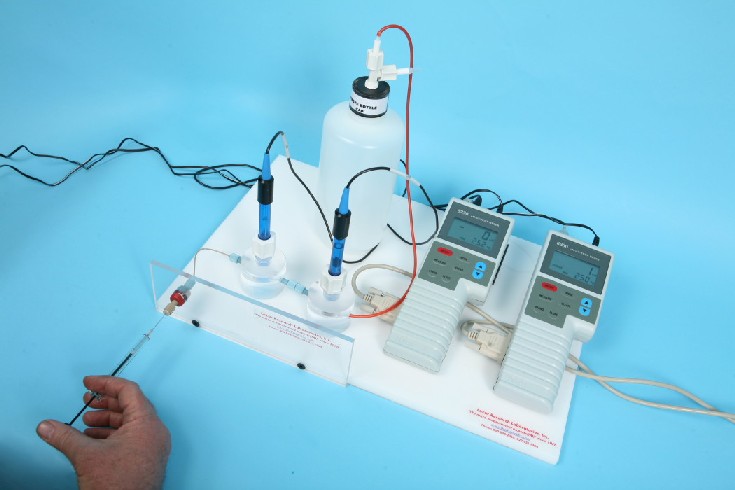ArrowSTRAIGHT?
Nitric Oxide Measurement System (NO2/NO3)
Your Straight Line to Accurate Results
ArrowSTRAIGHT?氮氧化物測(cè)量系統(tǒng)

在*小的樣本中進(jìn)行氮測(cè)試:血清��、尿液�����、血液、唾液����、組織勻漿��、細(xì)胞培養(yǎng)
**功能:不需要買昂貴的固定裝置�;
每個(gè)樣本都節(jié)約在抗氧化劑方面的支出��;
*小樣本制備步驟�����;
避免二氫煙酰胺腺嘌呤二核苷酸磷酸鹽和抗氧化劑的干擾�����;
消除三氧化氮—還原步驟���;
低檢測(cè)限�;
一氧化氮(NO)在多種哺乳動(dòng)物的生化過(guò)程中起著重要的作用�����,其中包括血壓穩(wěn)態(tài)����、**調(diào)節(jié)和神經(jīng)系統(tǒng)信號(hào)傳輸方面�。氮是非常不穩(wěn)定的�,它有一個(gè)生理半衰期1至40秒。即使用電化學(xué)分析法檢測(cè)氮���,對(duì)于其它的氮氧化合物而言���,由于快速降解使它難以被高度精準(zhǔn)地確定定量。氮的安培法實(shí)驗(yàn)是昂貴又浪費(fèi)時(shí)間的�,而且對(duì)運(yùn)營(yíng)商依賴性強(qiáng)。氮氧化后成為兩種穩(wěn)定的終級(jí)產(chǎn)品�����,亞硝酸鹽(NO2-)和硝態(tài)氮(NO3-)離子�����。這兩種**產(chǎn)品的濃度可以用來(lái)確定氮的產(chǎn)量�����,在測(cè)量過(guò)程中避免氮瞬間流失的問(wèn)題���。
有很多不同的方法可以定量測(cè)定亞硝酸鹽(NO2-)和硝態(tài)氮(NO3-)離子濃度�。*常見(jiàn)的方法就是Griess與(NO2-)反應(yīng)后產(chǎn)出一種含氮的的**產(chǎn)品�����。產(chǎn)出的**成品的顏色是紫色的����。然后使用使用比色或分光光度分析技術(shù)將它量化。這個(gè)比色技術(shù)有三個(gè)基本的問(wèn)題:首先���,抗氧化劑與(NO2-)反應(yīng)會(huì)出現(xiàn)額外困難的一步����,那就是完全還原亞硝酸鹽(NO2-)和硝態(tài)氮(NO3-)離子���。其次����,與所有的比色法一樣�,Griess技術(shù)可以影響原始樣本的顏色和濁度。*后��,這種方法是非常耗時(shí)和繁瑣的�����,因?yàn)樗婕皫讉€(gè)中級(jí)的化學(xué)反應(yīng)。
*近��,一個(gè)潛在的更準(zhǔn)確��,省時(shí)��,簡(jiǎn)潔的方法已被開(kāi)發(fā)用于測(cè)定NO2-和NO3-����。這依賴于使用亞硝酸鹽(NO2-)離子和硝態(tài)氮(NO3-)離子選擇性電*。這些電*被制作得很小����。將兩種樣本探測(cè)范圍降到低微摩爾范圍,這時(shí)電*可以測(cè)量50—100微升的小樣本����。無(wú)反應(yīng)檢測(cè)亞硝酸鹽(NO2-)和硝態(tài)氮(NO3-)離子從而還原亞硝酸鹽(NO2-)和硝態(tài)氮(NO3-)離子。由于這種方法被市場(chǎng)需求后���,微型電*系統(tǒng)變得更加完善�。它通過(guò)RS232或USB端口連接到PC或筆記本對(duì)兩種離子濃度進(jìn)行復(fù)雜的離子分析和準(zhǔn)確的測(cè)量。
規(guī)格:
微量亞硝酸鹽離子電*�����;
檢測(cè)限:5微克分子
反應(yīng)時(shí)間:45秒
*小樣本尺寸:50微升
硝酸鹽離子電*微
檢測(cè)限:3微克分子
反應(yīng)時(shí)間:45秒
*小樣本尺寸:50微升
ArrowSTRAIGHT?Nitric Oxide Measurement System (NO2/NO3)
Item number: ISM-146NOXM
英文原文:
ArrowSTRAIGHT?
Nitric Oxide Measurement System (NO2/NO3)
Your Straight Line to Accurate Results

|
Measure NO in Your Smallest Samples
-
Plasma
-
Serum
-
Urine
-
Whole blood
-
Saliva
-
Tissue homogenates
-
Cell Cultures
|
EXCLUSIVE FEATURES:
-
No expensive capital equipment to buy
-
Per sample cost savings over Griess
-
Minimize sample preparation steps
-
Avoid interferences from NADPH and antioxidants (Griess)
-
Eliminate NO3- reduction step (Griess)
-
Low detection limits
Nitric oxide (NO) plays a major role in a variety of mammalian biological processes including blood pressure homeostasis, immune regulation, and nervous system signal transmission. NO is very unstable and has a physiological half life of only 1 to 40 seconds. Even though there are electrochemical (amperometric) methods for detecting NO, its rapid degradation to other nitrogen oxide compounds makes it difficult to determine quantitatively with a high degree of accuracy. The amperometric method for assay of NO is expensive, time consuming, and operator dependent. NO oxidizes into two stable end products, namely nitrite (NO2-) and nitrate (NO3-) ions. The concentration of these two end products can be used to quantify NO production without the measurement problems caused by the transient nature of NO.
There are various methods for quantitatively determining the concentration of both NO2- and NO3- ions. The most common methods involved the use of the Griess reagent which reacts with NO2- ion to produce a stable azo end product which is purple in color and can be quantified using colorimeteric or spectrophotometric analytical techniques. There are three basic problems with this colorimetric technique. First of all, the Griess reagent only reacts with the NO2- compound thereby requiring an additional difficult step to completely reduce NO3- ion to NO2-. Secondly, like with all colorimetric methods, the Griess technique can be affected by original sample color or turbidity. Thirdly, this method is very time consuming and tedious because it involved several intermediate chemical reactions.
Recently a potentially more accurate, less time consuming, and less tedious method has been developed for assaying both NO2- and NO3- which relies on the use of ion selective electrodes for both NO2- and NO3- ions. These electrodes have been miniaturized to be able to measure samples down to 50 to 100 microliters with detection limits down to the low microMolar range for both species. Since both NO2- and NO3- ions can be measured individually no reaction to reduce NO3- to NO2- is required. This micro electrode system comes complete with a sophisticated ion analyzer which attaches via RS232 or USB port to a PC or laptop to give accurate concentration measurements for both ions.
SPECIFICATIONS
Nitrite micro ion electrode
Detection limit: 5 microMolar
Response time: 45 seconds
Minimum sample size: 50 microliters
Nitrate micro ion electrode
Detection limit: 3 microMolar
Response time: 45 seconds
Minimum sample size: 50 microliters
ArrowSTRAIGHT?Nitric Oxide Measurement System (NO2/NO3)
Item number: ISM-146NOXM